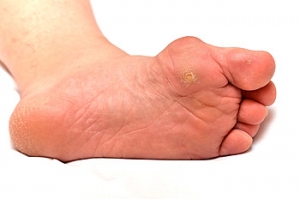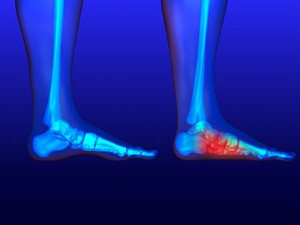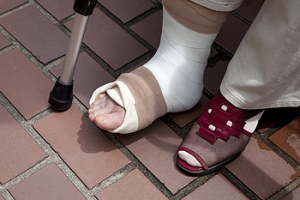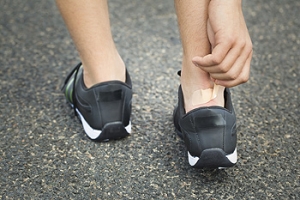Connect With Us
Blog

Causes of Corns
 A small area of skin that appears thickened on the foot may be a condition referred to as a corn. The general reason behind the development of corns commonly revolves around shoes not fitting properly, therefore putting pressure on the feet. An example of this are high-heels, which typically squeeze the toes and cause friction. Corns can be painful and may affect the overall balance of the foot, often causing discomfort while walking or running. Treating the corn ideally involves removing the source of pressure and friction, allowing the foot to move with less constraint in the shoe. There are two types of corns that exist, and they can occur in different areas of the foot. Moisture that generates in between the toes may cause soft corns. Alternatively, hard corns are typically found on the pinky toe, caused by friction from ill-fitting shoes. If the corn becomes severe, a consultation with a podiatrist may be suggested for proper treatment of the condition.
A small area of skin that appears thickened on the foot may be a condition referred to as a corn. The general reason behind the development of corns commonly revolves around shoes not fitting properly, therefore putting pressure on the feet. An example of this are high-heels, which typically squeeze the toes and cause friction. Corns can be painful and may affect the overall balance of the foot, often causing discomfort while walking or running. Treating the corn ideally involves removing the source of pressure and friction, allowing the foot to move with less constraint in the shoe. There are two types of corns that exist, and they can occur in different areas of the foot. Moisture that generates in between the toes may cause soft corns. Alternatively, hard corns are typically found on the pinky toe, caused by friction from ill-fitting shoes. If the corn becomes severe, a consultation with a podiatrist may be suggested for proper treatment of the condition.
If you have any concerns regarding your feet and ankles, contact one of our podiatrists of Family Foot Care of Long Island. Our doctors will treat your foot and ankle needs.
Corns: What Are They? and How Do You Get Rid of Them?
Corns can be described as areas of the skin that have thickened to the point of becoming painful or irritating. They are often layers and layers of the skin that have become dry and rough, and are normally smaller than calluses.
Ways to Prevent Corns
There are many ways to get rid of painful corns such as wearing:
- Well-fitting socks
- Comfortable shoes that are not tight around your foot
- Shoes that offer support
Treating Corns
Treatment of corns involves removing the dead skin that has built up in the specific area of the foot. Consult with Our doctors to determine the best treatment option for your case of corns.
If you have any questions please feel free to contact our office located in Port Jefferson Station, NY . We offer the newest diagnostic and treatment technologies for all your foot and ankle needs.
Corns: What Are They, and How Do You Get Rid of Them
Corns are thickened areas on the skin’s surface, to the point of being irritating and sometimes painful. Commonly found on the feet, corns are circular or cone-shaped. They develop where there are areas of pressure or friction, such as on the little toe when it rubs up against shoes, or on the ball of your foot.
Corns are often confused with a callus, but there is a difference between them. Corns can be raised bumps that are painful to the touch. They consist of a rough, thick area of skin that may be dry or waxy. Corns tend to be surrounded by skin that is inflamed, and are usually much smaller than calluses.
Removing the dead skin that has built up is the key in treating corns. Salicylic acid medication is most common in accomplishing this. The acid works by dissolving keratin, which is the protein that makes up the majority of corns. You can purchase salicylic acid over-the-counter in products such as wart removers. It comes in a variety of forms such as medicated pads, drops, or creams. However, people who are diabetic should not use salicylic acid, but should instead consult their doctor immediately.
According to the product directions, applying the medication directly onto the corn will treat it. The top layer of the corn will begin to turn white after use. When that occurs, the layers of skin can then be peeled away, making the corn smaller. Shaving off corns with razors or other pedicure equipment is never a good idea. This can lead to infection. If your corn gets infected, and is not treated immediately, a visit to the doctor will be necessary.
Another way to treat corns and help prevent their return is by using orthotic inserts, fitted by a podiatrist. Inserts fit right into your shoes and adjusts the way your foot fits into your shoes. This fixes the way you walk. This will lower your chances of getting corns, and eliminate current corns by reducing rubbing from friction.
Surgery is rarely used to treat corns, but does occur on occasion. Surgery actually deals with the underlying issue that causes corns. During surgery, the bone is shaved and any abnormalities are corrected, thus reducing the amount of friction that occurs during walking.
To prevent corns, the first step is reducing friction. Always wear shoes that fit well and don’t rub your feet. Pads can be purchased if you notice rubbing developing. These pads can be purchased over-the-counter, and can be simply placed on the irritated area. Wearing cushioned insoles in your shoes can always reduce the friction, and making sure to wear well-fitting shoes. This will ensure that your foot is not being squeezed awkwardly, and prevent corns from forming in the first place.
What Are Flat Feet?
 Flat feet is a common foot condition where young people typically have no painful symptoms, but may develop as they age. Flat feet may also be referred to as fallen arches, and commonly develop due to an inherited gene. The arch in the foot is not present or minimal, which causes the foot to lie flat against the floor while standing. The foot is comprised of 26 bones, in addition to numerous muscles and tendons. While walking, gravity from the weight of the body may cause pressure, often resulting in muscle imbalance, which may affect the arch of the foot. Age may also play a role in developing flat feet because the tendons surrounding the ankles may weaken, possibly causing the arches to fall. If you experience this condition, there are stretching exercises that can be performed to aid in preventing future foot issues from occurring. Please consider a consultation with a podiatrist if any pain is experienced for a proper diagnosis and treatment.
Flat feet is a common foot condition where young people typically have no painful symptoms, but may develop as they age. Flat feet may also be referred to as fallen arches, and commonly develop due to an inherited gene. The arch in the foot is not present or minimal, which causes the foot to lie flat against the floor while standing. The foot is comprised of 26 bones, in addition to numerous muscles and tendons. While walking, gravity from the weight of the body may cause pressure, often resulting in muscle imbalance, which may affect the arch of the foot. Age may also play a role in developing flat feet because the tendons surrounding the ankles may weaken, possibly causing the arches to fall. If you experience this condition, there are stretching exercises that can be performed to aid in preventing future foot issues from occurring. Please consider a consultation with a podiatrist if any pain is experienced for a proper diagnosis and treatment.
Flatfoot is a condition many people suffer from. If you have flat feet, contact one of our podiatrists from Family Foot Care of Long Island. Our doctors will treat your foot and ankle needs.
What Are Flat Feet?
Flatfoot is a condition in which the arch of the foot is depressed and the sole of the foot is almost completely in contact with the ground. About 20-30% of the population generally has flat feet because their arches never formed during growth.
Conditions & Problems:
Having flat feet makes it difficult to run or walk because of the stress placed on the ankles.
Alignment – The general alignment of your legs can be disrupted, because the ankles move inward which can cause major discomfort.
Knees – If you have complications with your knees, flat feet can be a contributor to arthritis in that area.
Symptoms
- Pain around the heel or arch area
- Trouble standing on the tip toe
- Swelling around the inside of the ankle
- Flat look to one or both feet
- Having your shoes feel uneven when worn
Treatment
If you are experiencing pain and stress on the foot you may weaken the posterior tibial tendon, which runs around the inside of the ankle.
If you have any questions please feel free to contact our office located in Port Jefferson Station, NY . We offer the newest diagnostic and treatment technologies for all your foot and ankle needs.
Flat Feet
Flatfoot is a foot condition in which the arch of the foot has either partially or totally dropped or has never developed. While it is common in babies and small children, it can become a problem for them in adulthood if the arch never forms. For adults, the development of flat feet can be brought upon by injury, as a result of pregnancy due to increased elasticity, or obesity. Those who have health concerns such as rheumatoid arthritis or diabetes may also be at greater risk for developing the condition.
If you suspect that you have flat feet, it is best to consult your podiatrist. Your foot doctor will examine the suspected foot and observe how it looks while you sit and stand. He or she may take an X-ray to determine how serious the condition is. Some common signs of flatfoot include toe drift, in which the toes and front part of the foot point outward, a short Achilles tendon, and a heel that tilts outwardly while the ankle tilts inward.
Once flatfoot has been diagnosed, your podiatrist may suggest one of several treatment options. Flat feet can be rigid, in which the feet appear to have no arch even when the person is not standing; or flexible, in which the person appears to have an arch while not standing, but once standing the arch disappears. Those with flexible flatfoot may be told to reduce any activities that cause pain and to avoid extended periods of walking or standing. Another suggestion may be weight loss, as excessive weight may be placing pressure on the arches
In few cases, if the condition is severe and all other methods have been exhausted surgery may be required. This is normally avoided, however, due to a lengthy recovery time and high cost.
Symptoms of a Broken Foot
 There are many ways to break your foot, and we wouldn’t recommend any of them. Severe pain when walking, in addition to bruising, are common symptoms of a foot that has been fractured. If limping occurs and the foot is tender when touched, these may be additional signs of a break in the bone. Obvious symptoms may include a deformity of the foot, which may indicate a joint dislocation. When the structure of the bone has been damaged, an x-ray is generally used to determine the extent of the injury. Once diagnosed, the injury may be treated by wearing a boot to help eliminate weight that is placed on the foot. A consultation with a podiatrist is advised for a proper diagnosis and additional treatment options.
There are many ways to break your foot, and we wouldn’t recommend any of them. Severe pain when walking, in addition to bruising, are common symptoms of a foot that has been fractured. If limping occurs and the foot is tender when touched, these may be additional signs of a break in the bone. Obvious symptoms may include a deformity of the foot, which may indicate a joint dislocation. When the structure of the bone has been damaged, an x-ray is generally used to determine the extent of the injury. Once diagnosed, the injury may be treated by wearing a boot to help eliminate weight that is placed on the foot. A consultation with a podiatrist is advised for a proper diagnosis and additional treatment options.
A broken foot requires immediate medical attention and treatment. If you need your feet checked, contact one of our podiatrists from Family Foot Care of Long Island. Our doctors can provide the care you need to keep you pain-free and on your feet.
Broken Foot Causes, Symptoms, and Treatment
A broken foot is caused by one of the bones in the foot typically breaking when bended, crushed, or stretched beyond its natural capabilities. Usually the location of the fracture indicates how the break occurred, whether it was through an object, fall, or any other type of injury.
Common Symptoms of Broken Feet:
- Bruising
- Pain
- Redness
- Swelling
- Blue in color
- Numbness
- Cold
- Misshapen
- Cuts
- Deformities
Those that suspect they have a broken foot shoot seek urgent medical attention where a medical professional could diagnose the severity.
Treatment for broken bones varies depending on the cause, severity and location. Some will require the use of splints, casts or crutches while others could even involve surgery to repair the broken bones. Personal care includes the use of ice and keeping the foot stabilized and elevated.
If you have any questions please feel free to contact our office located in Port Jefferson Station, NY . We offer the newest diagnostic and treatment technologies for all your foot and ankle needs.
Causes, Symptoms, and Treatment for a Broken Foot
One out of ten broken bones is reported to be in the feet. When an object crushes, bends, or stretches the bone beyond acceptable ranges, bones break. A break in the foot is either a fracture or a straight break.
The location of any break can tell you how the break happened. Toes, for instance, break typically as a result of something being kicked hard and with great force. Heel breaks almost always are a result of an improper landing from a tall height. Twists or sprains are the other two frequent occurrences. As with all usual breaks, they result from unexpected accident or sudden injury. As with stress fractures, breaks form as a process over time from repeated stress on already present cracks. Runners, dancers, and gymnasts are the usual athletes who receive this type of break. Stress fractures result from incredible pressure on the feet. It is no surprise these athletes bear the majority of reported fractures.
Pain, swelling, bruising, and redness are all indicative of the typical symptoms from a broken foot. Severe pain—to the point of not being able to walk—usually depends on the location of the break in the foot. Toes are on the lower scale of pain threshold, but heels are high, as are a few other particular bones. As the severity of the broken foot increases, symptoms like blueness, numbness, misshaping of the foot, cuts, or deformities will become apparent. These symptoms indicate the need to see a medical professional with access to an x-ray facility.
Prior to seeing a specialist, precautions should be taken to reduce pain and swelling. Elevate and stabilize the foot, and refrain from moving it. Immobilization of the foot is the next priority, so creating a homemade splint is acceptable. Keep in mind that while creating a splint, any increase of pain or cutting off blood circulation means that the splint should be removed immediately. Use ice to decrease swelling and relieve pain symptoms.
When dealing with a medical center, the patient should note that the treatment can vary. The treatment will depend on the severity of the fracture and the cause of the break. Crutches, splits, or casts are common treatments while surgery has been known to be used in more severe cases in order to repair the break in the bones.
Causes of Blisters
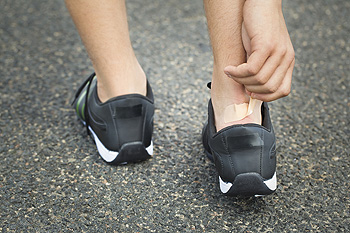 If you see a bubble-like area filled with fluid on the foot, you are most likely experiencing a blister. Friction is the most common cause of this condition, but there may be several other reasons for this to occur. Exposure to certain chemicals, an infection from an insect bite, or being the victim of a severe burn may all be contributing factors for developing a blister. The fluid in the blister is produced by the human body to cover the damaged area and protect the skin. Blisters commonly develop on the toes and the back of the foot due to friction. This is most often caused by walking and running long distances, in addition to wearing shoes that are ill-fitting. If your foot is exposed to extremely cold temperatures, blisters may appear because of tissue damage caused by frostbite. Generally, blisters will heal on their own. However, if the blister should burst causing an infection, it’s advised to seek the medical attention of a podiatrist.
If you see a bubble-like area filled with fluid on the foot, you are most likely experiencing a blister. Friction is the most common cause of this condition, but there may be several other reasons for this to occur. Exposure to certain chemicals, an infection from an insect bite, or being the victim of a severe burn may all be contributing factors for developing a blister. The fluid in the blister is produced by the human body to cover the damaged area and protect the skin. Blisters commonly develop on the toes and the back of the foot due to friction. This is most often caused by walking and running long distances, in addition to wearing shoes that are ill-fitting. If your foot is exposed to extremely cold temperatures, blisters may appear because of tissue damage caused by frostbite. Generally, blisters will heal on their own. However, if the blister should burst causing an infection, it’s advised to seek the medical attention of a podiatrist.
Blisters are prone to making everyday activities extremely uncomfortable. If your feet are hurting, contact one of our podiatrists of Family Foot Care of Long Island. Our doctors can provide the care you need to keep you pain-free and on your feet.
Foot Blisters
Foot blisters develop as a result of constantly wearing tight or ill-fitting footwear. This happens due to the constant rubbing from the shoe, which can often lead to pain.
What Are Foot Blisters?
A foot blister is a small fluid-filled pocket that forms on the upper-most layer of the skin. Blisters are filled with clear fluid and can lead to blood drainage or pus if the area becomes infected.
How Do Blisters Form?
Blisters on the feet are often the result of constant friction of skin and material, usually by shoe rubbing. Walking in sandals, boots, or shoes that don’t fit properly for long periods of time can result in a blister. Having consistent foot moisture and humidity can easily lead to blister formation.
Prevention & Treatment
It is important to properly care for the affected area in order to prevent infection and ease the pain. Do not lance the blister and use a Band-Aid to provide pain relief. Also, be sure to keep your feet dry and wear proper fitting shoes. If you see blood or pus in a blister, seek assistance from a podiatrist.
If you have any questions, please feel free to contact our office located in Port Jefferson Station, NY . We offer the newest diagnostic and treatment technologies for all your foot care needs.
Blisters on the Feet
Blisters are a common ailment of people who wear shoes that are either too tight or rub against the feet in an uncomfortable way. Knowing the basics of blisters is important for understanding how they are formed and what treatments should be used for them.
A blister on the foot, or any other part of the body, is a small pocket that is filled with fluid. It usually forms on the upper layer of the skin because these layers are loose enough to allow a blister to form. The most common fluid in a blister is just a clear, watery-like fluid that usually isn’t cause for concern. However, blisters can fill up with blood if they are deep enough and pus if they have become infected with bacteria.
Blisters almost always form on the feet due to shoes rubbing up against the foot, where the friction causes blisters. These can occur after you have walked for a long period of time or when your shoes do not fit you properly. Your feet are also more prone to blisters if they are moist, so keeping them dry and clean is one preventative step you can take.
Preventing infection should be the number one concern when treating blisters, as well as relieving the pain they can cause. Using a bandage to cover up the blister will help it heal and prevent bacteria from entering it. New skin will form under the blister and eventually cause it to pop. You can also take a sterilized pin and try to pop it yourself.
If the blister is filled with pus or blood, seeking treatment from a doctor is ideal. Antibiotics may need to be taken in order to completely eliminate the bacteria inside the blister. See a doctor to have an antibiotic prescribed.
The best way to treat blisters is to prevent them all together. Keeping your feet dry and making sure that your shoes fit properly are just two of the steps you can take to prevent blisters. Shoes that are too tight or shoes that are too loose and allow your feet to slide in them will cause blisters. Applying a bandage to an area where you think a blister is about to form is another way you can prevent them.
Options on How to Measure Your Feet
 Comfort is one of the most important things to look for when buying shoes, and comfort starts with measuring your feet correctly so proper shoes can be chosen for maximum support. There are several ailments that can occur from wearing shoes that fit poorly, which include blisters, cuts on the feet, and long-term injuries. Measuring the feet periodically will aid in choosing the correct size, and this can be done on a Brannock device which is typically found in shoe stores. An alternative to this tool is to measure the length and width of the foot on paper by tracing the outline of your foot. This may help you determine if a wider or narrower width is needed for optimum comfort. Please consider a consultation with a podiatrist for more information on how to determine your proper shoe size.
Comfort is one of the most important things to look for when buying shoes, and comfort starts with measuring your feet correctly so proper shoes can be chosen for maximum support. There are several ailments that can occur from wearing shoes that fit poorly, which include blisters, cuts on the feet, and long-term injuries. Measuring the feet periodically will aid in choosing the correct size, and this can be done on a Brannock device which is typically found in shoe stores. An alternative to this tool is to measure the length and width of the foot on paper by tracing the outline of your foot. This may help you determine if a wider or narrower width is needed for optimum comfort. Please consider a consultation with a podiatrist for more information on how to determine your proper shoe size.
Getting the right shoe size is an important part of proper foot health. Seek the assistance of one of our podiatrists from Family Foot Care of Long Island. Our doctors will provide the care you need to keep you pain-free and on your feet.
Getting the Right Shoe Size
There are many people who wear shoes that are the incorrect size, negatively affecting their feet and posture. Selecting the right shoes is not a difficult process, so long as you keep several things in mind when it comes to choosing the right pair.
- When visiting the shoe store, use the tools available to measure your foot.
- Be sure there is ‘wiggle room’. There should be about an inch between your toes and the tip of your shoes.
- Do not always assume you are the same size, as manufacturers run differently.
- Purchase shoes later in the day, as your feet swell as the day progresses.
- If a shoe is not comfortable, it is not suitable. Most shoes can’t be ‘broken in’, and comfort should be the ultimate goal when it comes to choosing the right pair of shoes
As our feet hold our body weight and keep us moving, it is important to treat them right. Picking the right pair of shoes can provide your feet comfort and mobility without pain.
If you have any questions, please feel free to contact our office located in Port Jefferson Station, NY . We offer the newest diagnostic and treatment technologies for all your foot care needs.
Getting the Right Shoe Size: To Keep Your Feet Happy
People are constantly wearing improperly-fitting shoes. Though it isn’t hard, picking the right shoes does require keeping a few things in mind.
Shoe stores have rulers so you can get an exact measurement of your feet. Be sure to always measure your feet with your shoes on. Measuring just your foot will give you a shoe size that is 1-2 inches too small for picking the right size shoe.
To ensure that your toes won’t be cramped, make sure there is wiggle room. Approximately one inch should be between your toes and the tip of your shoe. It is easy to tell if your shoes are too tight, because you will start to experience pain, blisters, and swelling.
Additionally, do not always assume your shoe size will be the same at every store. Manufacturers sometimes run differently, and your size will vary from brand to brand. Make sure the stores you purchase from have return policies, in case there is a problem.
Rather than shoe shopping in the morning, it is advised to shop for shoes later in the day. Your feet will swell as the day passes. If shoes are purchased in the morning, they may not be as snug as they should be. Furthermore, not all two feet are the same size. Therefore, accommodations may be necessary.
An overall concern in buying shoes is making sure they are comfortable and supportive. There is no such thing as a shoe being ‘broken in’. If they are uncomfortable at the store, they likely will always be uncomfortable.
Since we do a lot of walking, it is important that we pick the right shoes. Our feet will benefit from this, and we will be happier and healthier because of it.
Blog Archives
- May 2025
- April 2025
- March 2025
- February 2025
- January 2025
- December 2024
- November 2024
- October 2024
- September 2024
- August 2024
- July 2024
- June 2024
- May 2024
- April 2024
- March 2024
- February 2024
- January 2024
- December 2023
- November 2023
- October 2023
- September 2023
- August 2023
- July 2023
- June 2023
- May 2023
- April 2023
- March 2023
- February 2023
- January 2023
- December 2022
- November 2022
- October 2022
- September 2022
- August 2022
- July 2022
- June 2022
- May 2022
- April 2022
- March 2022
- February 2022
- January 2022
- December 2021
- November 2021
- October 2021
- September 2021
- August 2021
- July 2021
- June 2021
- May 2021
- April 2021
- March 2021
- February 2021
- January 2021
- December 2020
- November 2020
- October 2020
- September 2020
- August 2020
- July 2020
- June 2020
- May 2020
- April 2020
- March 2020
- February 2020
- January 2020
- December 2019
- November 2019
- October 2019
- September 2019
- August 2019
- July 2019
- June 2019
- May 2019
- April 2019
- March 2019
- February 2019
- January 2019
- December 2018
- November 2018
- October 2018
- September 2018
- August 2018
- July 2018
- June 2018
- May 2018
- April 2018
- March 2018
- February 2018
- January 2018
- December 2017
- November 2017
- October 2017
- September 2017
